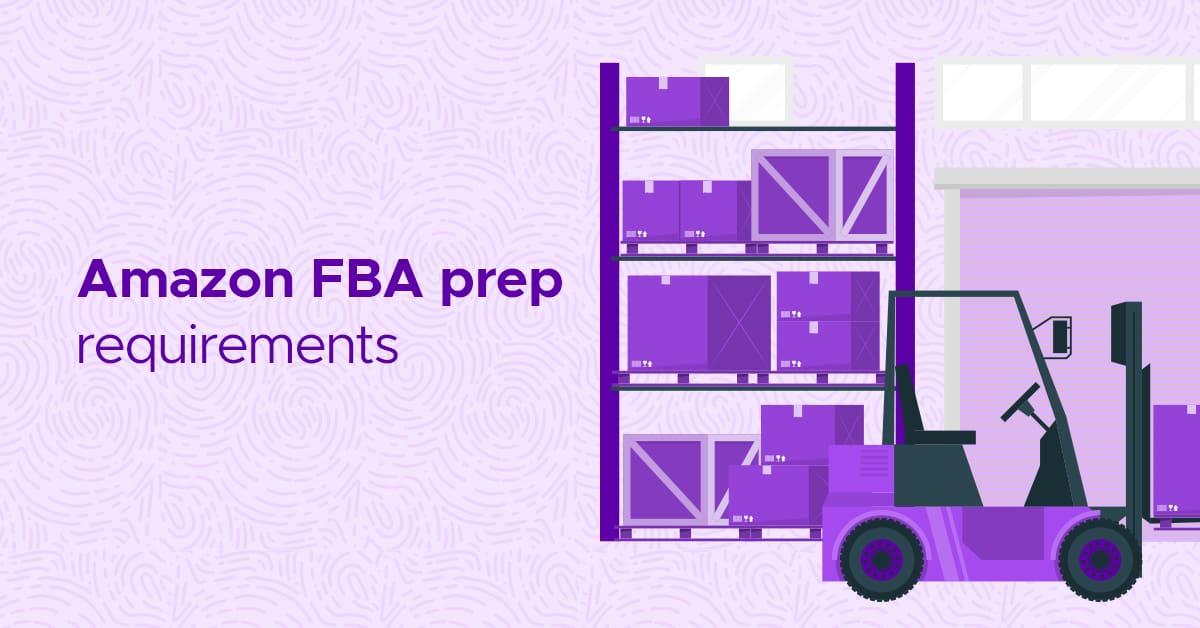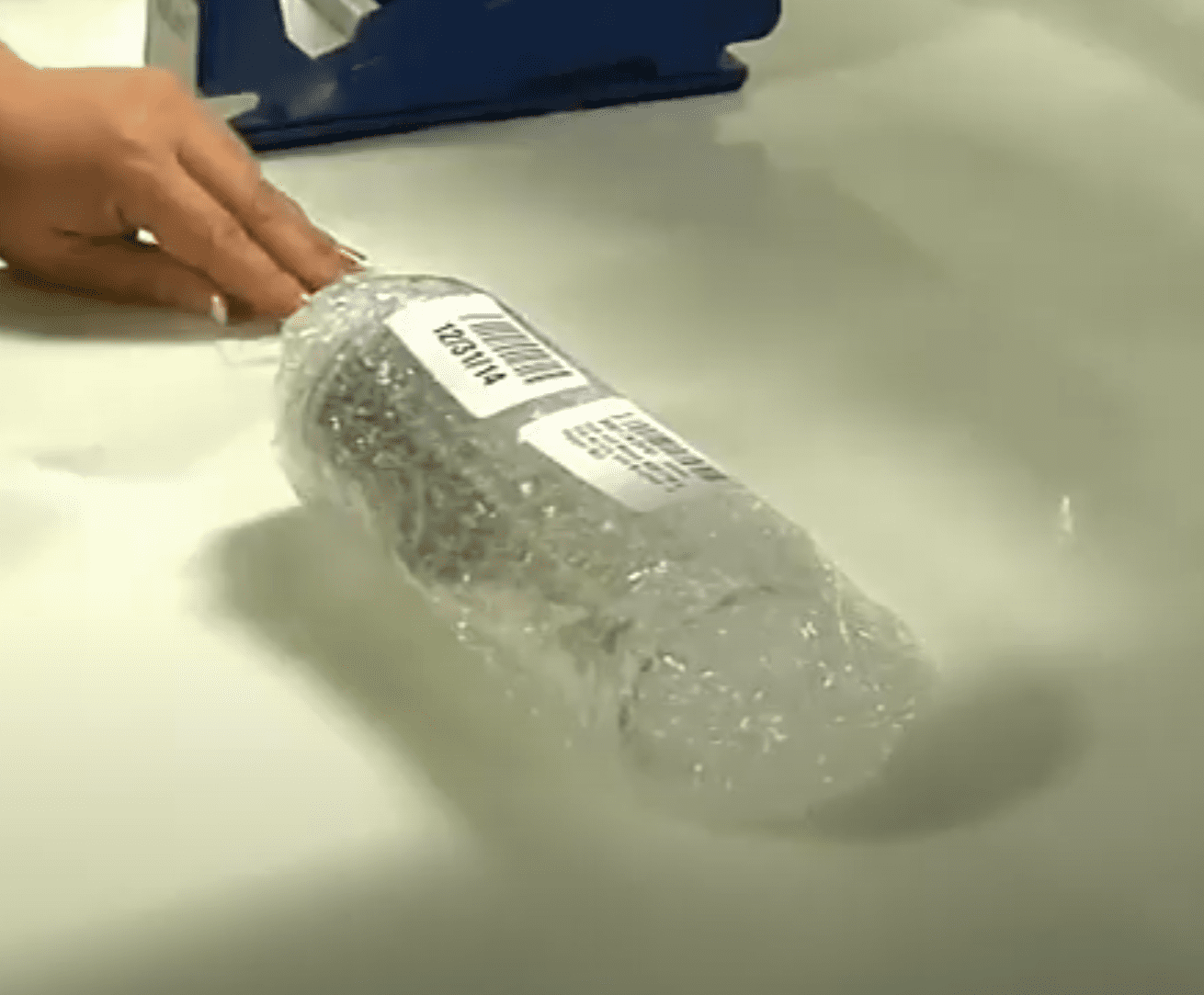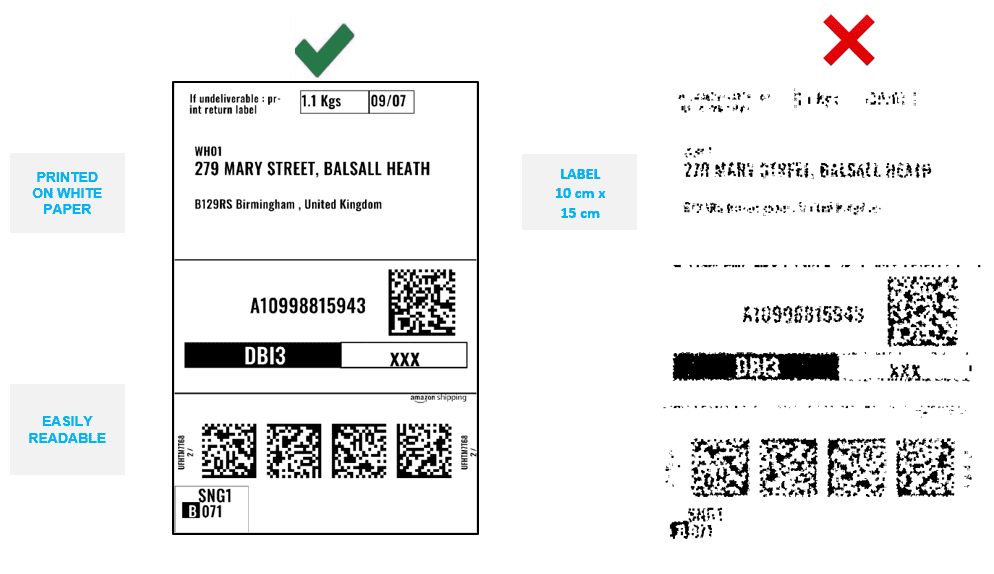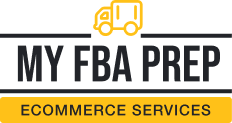
Amazon FBA Prep Requirements: Labeling & Packaging Guide

To succeed as a seller in the Fulfillment by Amazon (FBA) program, you must adhere to its stringent guidelines. With standards encompassing everything from packaging and labeling to shipping, your ability to comply spells the difference between seamless operations and costly delays.
So, to help you circumvent any issues and reach customers without a hitch, we’ll walk you through the intricacies of the many FBA prep requirements.
A brief overview of FBA
The FBA program lets third-party sellers utilize Amazon’s end-to-end fulfillment capabilities. This entails the eCommerce giant handling the following responsibilities on your behalf:
- Inventory storage and management
- Picking and packing
- Shipping and customer service
Off-loading these tasks removes their associated complexities and creates more bandwidth for strategic business activities while maximizing the marketplace’s fast and reliable fulfillment.
That being said, failure to adhere to Amazon FBA prep requirements will result in Amazon refusing, returning, or repackaging any item you send to one of their fulfillment centers — at your expense. Amazon may also enforce additional guidelines for your product, particularly when it suffers damages or results in damage-related returns.
Amazon FBA prep requirements
To ensure products are safely handled and easily identified, Amazon mandates that FBA sellers follow their packaging and Amazon FBA prep requirements before sending their goods to designated fulfillment centers.
General packaging guidelines
Obviously, every item you hand off to Amazon must be packaged securely so it can withstand the rigors of shipping and handling. However, the marketplace has other demands for goods across categories:
- Every product or unit must have a corresponding unique FNSKU. Any variant, such as an item’s size or color, should have one as well.
- Each unit must have an accessible and scannable barcode or label with matching readable numbers on its exterior.
- To prevent incorrect barcodes from being accidentally scanned during the receiving process, render existing ones on shipping box exteriors unscannable. You can do this by obscuring them with opaque tape or felt-tip markers.
- Don’t attach anti-theft instruments to products you ship to designated fulfillment centers.
Beyond these Amazon FBA prep requirements, Amazon has FBA prep guidelines for specific scenarios.
Loose products
Every loose item (think individual volumes in a book set) must be placed securely in a single package. Certain products that aren’t contained in one must be bagged individually or secured with removable tape or a non-adhesive band.

Image source: YouTube
Their barcodes must be scannable without the fulfillment center having to unpack or unwrap them. Amazon has a helpful video showing how this works. Also, keep these Amazon FBA prep requirements tips in mind:
- Amazon won’t accept items that require assembly (e.g., a table and its separate legs sold as one unit).
- Pack all footwear in shoe boxes or poly bags with a suffocation warning and without any of their material exposed.
Sold as set
Individual items sold together as sets must be clearly labeled “Sold as set” to ensure they aren’t separated during handling. You can also use something like “This is a set. Do not separate” or “Ready to ship.”

Image source: YouTube
Units not contained in secure packaging must be shrink-wrapped or placed in a clear poly bag with a suffocation warning before you add labels. Amazon’s video demonstrates this task clearly.
Each included item and the set itself must have a unique ASIN. Also, every item contained within the set must have their barcodes covered to ensure only the set’s barcode is scanned.
Boxed units
Boxed products should be six-sided and able to withstand medium pressure on all sides without collapsing. They must also have openings or a lid that won’t open on its own. Otherwise, they should be sealed with tape, glue, or staples.
If your boxed item has perforated sides or openings, it must pass a series of three-foot drop tests, one performed on each side and on a corner. If it fails to meet Amazon FBA prep requirements, it must be sealed in a poly bag with a suffocation warning.
Poly-bagged units
The poly bags that protect your items must meet certain specifications as well. They should be transparent and at least 1.5 mil (thousandth of an inch) thick. Bags must also have prominent suffocation warnings if their openings are five inches or greater.
If it doesn’t have a safety notice, your product may be re-bagged. Depending on the poly bag’s size, your warning must adhere to a specific print size to meet Amazon FBA prep requirements:
| Total length plus width of bag | Minimum print size |
| 60 inches or more | 24 point |
| 40 to 59 inches | 18 point |
| 30 to 39 inches | 14 point |
| Less than 29 inches | 10 point |
Your poly bags must also comply with these requirements:
- They must be completely sealed.
- They must have barcodes (like a UPC or EAN) or X00-label that are scannable through the bags, or have an X00- or ASIN label on the exterior.
- The poly bag or shrink wrap must not protrude more than three inches beyond your product’s dimensions.
- The poly bag or shrink wrap must be black and opaque when packaging adult products.
Bubble wrap
Items that are fragile (i.e., can be damaged easily during transit) or heavy or dense (i.e., can damage other goods during transit) must be bubble wrapped. Further, bubble-wrapped products should meet these criteria:
- Tightly wrapped and taped so the contents don’t fall out
- Labeled with a scannable barcode on the exterior
- Able to pass a series of three-foot drop tests (similar to the ones for boxed units) on a hard surface without the contents breaking.
Over-boxing
When safety concerns about shipping and handling arise, prepared, packaged, or boxed products must be placed in another box for added protection. Items over 10 pounds, meanwhile, must use double-wall corrugated boxes.
Over-boxing is also necessary for these types of products:
- Sharp items that can puncture packaging
- Fragile items that could be damaged during shipping and handling or failed the series of three-foot drop tests despite being bubble wrapped
- Over 4.2 ounces of hazardous liquids in glass containers
- Vinyl records
Hanger removal
All hangers must be removed from apparel or clothing, with the exception of mini hangers for baby clothes. Even accessories, bras, hats, shorts, socks, and the like can’t be shipped on a hanger according to Amazon FBA prep requirements.
Tape
FBA’s tape requirement applies to products that need extra taping to seal or secure a box, poly bag, or the bubble wrap around them properly. This is a necessity when an item:
- Could fall out of its packaging if not taped shut
- May leak if its lid isn’t secured
- Isn’t fully sealed within its container
Mattress packaging
When creating an ASIN for a mattress, make sure it’s correctly categorized under: Home & Kitchen > Furniture > Bedroom Furniture > Mattresses & Box Springs > Mattresses. As for prep, package it in a corrugated box.
Case-packed products
Case-packed boxes must contain units with a single matching SKU and condition and be in their original manufacturer packaging. Those containing the same product must have equal quantities of it in each box, but note that the case pack limit is 150 units per case. For a more detailed explanation, watch Amazon’s video on these Amazon FBA prep requirements.
Also, remember the following guidelines when sending case-packed boxes to designated fulfillment centers:
- During receiving and before placing the box in FBA inventory, only one unit inside is scanned, since every box contains the same number of items.
- Only the items within the case can have scannable bar codes, so remove any from the exterior.
- Sometimes, manufacturers or distributors place more than one case pack into a larger box. These don’t qualify as a case pack and so must be separated based on their appropriate levels.
Expiration dates
Expiration dates must be clearly displayed on both the individual items and their packaging, following the format “MM-DD-YYYY” or “MM-YYYY.” If the original is printed in a different format, it must be covered with a sticker that uses the correct one.

Image source: YouTube
Additional rules are as follows:
- The product’s remaining shelf life must be more than 90 days from the date it’s received at Amazon’s fulfillment center.
- Expiration dates must be placed on an item’s outer box in 36-point font or larger. Lot numbers alone are insufficient.
- Products that must be poly-bagged or bubble wrapped should have labels with expiration dates applied to their packaging’s exterior, as they must be accessible to Amazon associates during the check-in process.
- Perishable items are prohibited.
Marketing materials
Refrain from including marketing materials (e.g., pre-priced labels, pamphlets, price tags, other non-Amazon labels) inside prepped items, as they won’t be accepted unless they’re part of the product.
Safety
Amazon FBA prep requirements state you to use safety knives with covered blades when prepping products to prevent injuries from sharp objects accidentally left inside boxes.
Other requirements
Amazon may enforce additional Amazon FBA prep requirements for certain product categories, so always check their guidelines for more information. Some examples include:
- Liquids, pastes, gels, and creams
- Pellets, powders, and granular products
- Plush units
- Apparel, fabric, and textiles
- Baby products
FBA product barcode requirements
Every item you ship to a designated fulfillment center requires a barcode so that FBA can identify and track your goods throughout fulfillment. Amazon utilizes two types: manufacturer and Amazon barcodes.
Manufacturer barcodes
Unless your settings specify the use of an Amazon barcode, Amazon will use a manufacturer one by default (eligible ones include UPC, EAN, JAN, and ISBN). If more than one seller of a product employs a similar manufacturer barcode, Amazon can fulfill orders using goods that are closest to the buyer for speedier shipping.
Amazon barcodes
Amazon barcodes are FNSKU labels that start with an X. These must be applied to all products not tracked through manufacturer barcodes, as they tell Amazon the items you shipped are tied to your seller account. FNSKUs also make it easier to monitor inventory because they prevent your stock from mingling with other sellers’.
Note: You can print Amazon barcodes and place them on goods yourself or have Amazon do it for a per-item fee.
Amazon FBA prep requirements for shipping
Once you’ve followed Amazon FBA prep requirements for packaging and barcodes, and are ready to send your goods to FBA’s fulfillment centers, you must follow the program’s shipping requirements.
Box content information
Amazon asks for the details of your box’s contents to simplify inventory management on their end. Providing precise information also makes your products available for sale quickly and helps you avoid manual processing fees.
So, ensure the details listed on your shipping plan match the shipment you send to the fulfillment center and include:
- Your merchant SKU
- The item’s UPC/EAN/ISBN or other external barcode
- FNSKU
- The product’s condition
- The quantity you sent
- Whether the shipment is packed individually or in a case
- The box’s weights and dimensions
Additionally, each box you ship should only contain inventory from one shipment ID. Make sure you don’t combine items from multiple shipments in a single box.
Packaging your shipments
Amazon FBA prep requirements also lays out instructions so your shipments arrive at fulfillment centers undamaged and ready for intake:
- Use a rigid, six-sided box with intact flaps.
- Apply a single address label with clear and complete delivery and return information.
- Every box included in your shipment should have a unique FBA box ID label printed from your Shipping Queue (located in Seller Central).
- Every pallet requires four FBA pallet ID labels, one on the top center of each side. Each box on the pallet must also have a unique FBA box ID label.
- When shipping multiple case packs in a single, larger box, the unique FBA box ID shipping label should be placed on the primary box’s exterior.
- Remove all old shipping labels, barcodes, or markings when reusing boxes.
- To prevent incorrect barcodes from being accidentally scanned during the receiving process, render existing barcodes unscannable with opaque tape or a black, felt-tip marker.
- Wrap every item separately.
- Use sufficient packaging material.
- Secure with strong shipping tape.
- Place two inches of cushioning between every item and the box’s interior.
- Shake your box gently after packing. Its contents shouldn’t move while doing so.
- Using boxes with dimensions of at least 6 x 4 x 1 inches and weighing at least one pound can minimize receiving delays.
Remember to account for Amazon’s box specifications as well:
- Maximum box dimensions: Can’t exceed 25 inches on any side
- Maximum box weight: Can’t exceed 50 pounds total
Surpassing the box requirements may delay or limit your ability to send FBA shipments, so adhere to them strictly. There is an exception, however, for individual oversized items that exceed the above box size and weight limitations. In such instances, take the following actions:
- For single items that weigh more than 50 pounds: Place a label that clearly indicates “Team Lift” on the box’s top and sides.
- For single items that weigh more than 100 pounds: Place a label that clearly indicates “Mechanical Lift” on the box’s top and sides.
Packing materials
When shipping your inventory to FBA’s fulfillment centers, you’re required to use packing materials that protect Amazon’s associates from potential safety threats. They also ensure your shipment sails through the receiving process. Amazon mandates that sellers:
Use
- Bubble wrap
- Full sheets of paper (heavy-weight kraft paper is best)
- Inflatable air pillows
- Polyethylene foam sheeting
Don’t use
- Any type of packing peanuts
- Foam strips
- Crinkle wrap
- Shredded paper
- Thermocol chips
- Styrofoam
What to avoid
It’s easier if FBA shipments arrive at fulfillment centers ready for intake, so, to support that seamlessness, Amazon also advises sellers to avoid:
- Point-of-sale containers, meaning those that typically come with individual units of what you’re selling (i.e., their original packaging)
- Open boxes used for display purposes, like those without tops or with open fronts
- Pallet-sized boxes, also known as “gaylords”
- String, straps, or over-wrap (plastic or paper)
- Bundling multiple boxes together
A guide to FBA shipping labels
Correct labeling is crucial for your shipment’s efficient processing. So, you must comply with Amazon FBA prep requirements guidelines for FBA shipping labels.
Shipping methods and carriers
Before you place a label on your shipment, you must first identify the right shipping method and carrier. That choice will depend on the sizes, quantities, and types of your shipments:
- Small parcel delivery (SPD): This is for smaller shipments consisting of one or a few boxes. It’s best for sellers who send in small amounts of inventory. Each box in your shipment should have its own unique FBA shipment label.
- Less-than-truckload (LTL) or full-truckload (FTL): These are for larger shipments. As their names imply, LTL is ideal for shipments that don’t take up an entire truck, while FTL is for those that do. Both are cost-efficient options for bulk inventory shipping.
Label requirements
Next, you must abide by these FBA label specifications.
Content
Each label must include necessary information like:
- The item’s name
- Its condition (new, used, etc.)
- A clear and scannable barcode
- Shipment ID
- Quantity
- Seller information, depending on the format
- Destination address
- Safety and handling information, depending on the product
Quality
Poor print quality can result in scanning issues that delay fulfillment. Due to this, shipping labels must be printed with high quality, using black ink on white and non-reflective labels.
Barcode scannability
Your labels’ barcodes must be clear and easily scannable, free of smudges and distortions. Here’s a comparison of what Amazon does and doesn’t accept, according to their guide:

No additional markings
To avoid any confusion during scanning and sorting, your FBA shipping labels shouldn’t have any extra markings or information that Amazon doesn’t specify.
Safety information
Products that are regulated (like hazardous materials) or require special handling must have their safety and compliance information prominently displayed on their FBA shipping labels.
Amazon FBA box label requirements
Besides Amazon FBA prep requirements for shipping labels, you must comply with their box label guidelines as well.
Size and visibility
An FBA box label’s standard size is 3 ⅓ inches by 4 inches. It must be clearly visible and affixed to a flat surface of the box, meaning it shouldn’t be applied over a seam or edge where it may become damaged or unscannable.

Placement
Your FBA shipping labels should be easily accessible and scannable. So, again, place them on a flat surface of the box, namely its top or side. Don’t affix them on box corners or folds.
Avoid duplication
Every box in your shipment must have its own unique FBA label. You can create a custom Amazon template, but don’t duplicate labels and then apply them to multiple boxes. This can cause confusion and errors during fulfillment, which leads to delays.
Cover existing barcodes
To prevent confusion during scanning, an existing manufacturer barcode on a product must be covered with an FBA shipping label.
Legibility and durability
Your Amazon FBA box label should be resistant to smudging and wear so the text and barcodes remain legible throughout shipping. So, avoid placing it in areas where packages experience the most handling.
A guide to FBA-compliant custom packaging
With the slew of labeling and packaging requirements Amazon enforces, some FBA sellers find it difficult to showcase their brand. There are ways to do this though, and it’s possible to use custom packaging while still complying with the platform’s guidelines. To help you out, we’ll walk you through the rules.
Avoid conflicts with Amazon FBA prep requirements
Since Amazon FBA prep requirements are strict, comb through every component, from your ink to your logos. To ensure barcodes are easily scannable, for instance, avoid packaging elements that obscure these crucial elements to avoid issues with processing.
Print inside the box
Your boxes’ exteriors must adhere to rules regarding labels and barcodes, so opt for customizing their interiors. For example, you could print your brand story, user-generated content (UGC), or interactive challenges and puzzles to make unboxing more engaging and memorable. This tactic also keeps FBA barcodes and labels untouched.
Try branded tape or stickers
Replace regular tape with custom to showcase your brand’s colors, logo, and, ultimately, its identity. Just make sure it doesn’t compromise your package’s security or obstruct essential information, labels, or barcodes.
Use custom inserts and void fill
Product inserts keep items safe and immobile during transit, thus reducing the risk of damage. Custom ones, meanwhile, can improve an order’s aesthetics. Take advantage of this subtle staying power by incorporating branding, whether it be through colors, logos, or short messages.
This strategy can also apply to void fill since it’s also a part of your packaging that keeps products locked in place.
Enroll in the Ships in Product Packaging (SIPP) program
Amazon’s SIPP program guarantees your custom packaging adheres to Amazon FBA prep requirements, allowing you to test and qualify your design and products. Passing and successfully enrolling lets you ship FBA inventory in your branded packaging without Amazon adding extra material. The program also supports enhanced customer experiences, a reduced environmental footprint, and regulatory compliance.
Wrapping up — Ensure seamless fulfillment by complying with Amazon FBA prep requirements
Understanding and adhering to Amazon FBA prep requirements is essential for you to succeed on Amazon, but abiding by the comprehensive guidelines requires a lot of time and effort.
However, a strong FBA prep partner enables you to circumvent these complexities and frees up time for endeavors with greater strategic value, like product development and scaling. MyFBAPrep can help in this regard: Our Amazon FBA prep services ensure your goods are compliant, well protected, and efficiently processed so they seamlessly enter Amazon’s fulfillment network.
With our assistance, you not only avoid costly delays but also enrich customer experiences and strengthen your brand reputation. If you want to learn more about how we can build smooth and compliant operations for you, don’t hesitate to reach out.
